The practice of seed cycling has been around for decades. It’s often touted as a method to naturally balance hormones and regulate the menstrual cycle.
But does seed cycling actually work?
Does eating different seeds depending on where you are in your cycle really help to regulate your hormones and improve your fertility?
Keep reading to learn the answers to these questions, along with my recommendations for balancing hormones, with or without seed cycling.
Seed cycling is promoted as being a gentle and effective way to use food as medicine. Proponents of this practice say that it can balance your hormones and make your period problems disappear.
When we’re experiencing any range of hormonal issues, from PMS to missing periods, we’ll likely try anything to get our cycle back on track and minimize those unpleasant symptoms. So seed cycling can seem like an attractive option.
My goal with this platform (and as a fellow woman with occasional period problems herself) is to dig through the misinformation and hype around trendy health topics.
I’m here to provide you with the information and resources to help you live your healthiest life. A life free from any fear and dogma when it comes to the decisions you make around your health.
Dealing with hormonal imbalances or symptoms at any stage in your cycle can be a roadblock that prevents you from being your healthiest, most vibrant self.
When it comes to seed cycling and its claims to help regulate your cycle, I want to help you decide if this is something worth investing your time and energy in.
Ready to learn more about seed cycling, and if it’s a good fit for you? Let’s go!

An Overview of The Menstrual Cycle
The premise behind seed cycling is that you rotate seeds based on where you are in your menstrual cycle. So understanding what happens during each phase of your cycle will help you better understand why you cycle seeds in the first place.
The menstrual cycle can be split into two distinct phases.
The first phase, the follicular phase, lasts from the day you start your period until the day you ovulate.
This portion of our cycle can vary greatly in length from woman to woman, and even from cycle to cycle in the same woman.
Ideally, your follicular phase should be around 14-21 days. Issues like stress, PCOS, and low Vitamin D levels are just a few reasons why this phase could last longer than expected.
The second phase, the luteal phase, starts on the day you ovulate and ends the day before your next period.
This phase is typically going to be the same length, give or take a day or two, for each woman. Ideally, it should be as close to 14 days as possible.
(A short luteal phase, 10 days or less, is usually caused by the body not producing enough progesterone. This is often due to a lack of ovulation, or an “anovulatory” cycle.)
Our primary sex hormones, estrogen and progesterone, present differently during each of these phases.
The follicular phase is dominated by estrogen, while progesterone is highest during the luteal phase.
Charts like the one below are useful for helping to visualize the hormonal changes during each phase of our cycle.
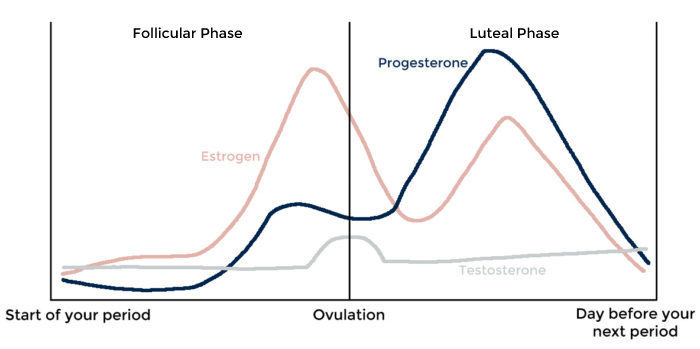
As you can see, there’s a lot going on behind the scenes when it comes to our period.
So, now that we’ve looked at our hormonal changes throughout our cycle, let’s dig into how seed cycling might help correct them!
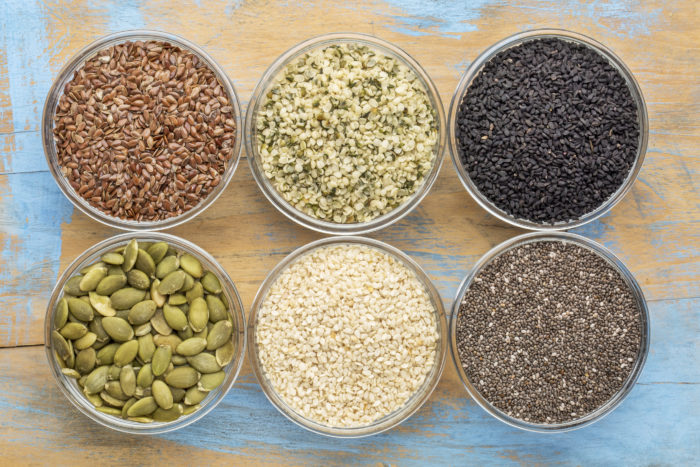
What is Seed Cycling?
Seed cycling is the practice of consuming different seeds at different times during the menstrual cycle. This method of cycling seeds is meant to help support optimal hormone balance and help regulate your cycle.
The premise is that different seeds support one of the dominant hormones during each phase of your cycle.
During the follicular phase, you consume seeds that are supportive of healthy estrogen production. And during the luteal phase, you would do the same with seeds that support optimal progesterone.
It’s important to note that seed cycling doesn’t directly provide your body hormones the way something like birth control does.
Seed cycling simply provides you with nutrients and naturally-occurring plant compounds that help you create and properly metabolize your own hormones.
For example, consuming estrogen-balancing seeds during your follicular phase won’t cause you to produce more estrogen. But they may support your body in producing and metabolizing estrogens more efficiently.
Confused? Let’s get into the nitty-gritty details!
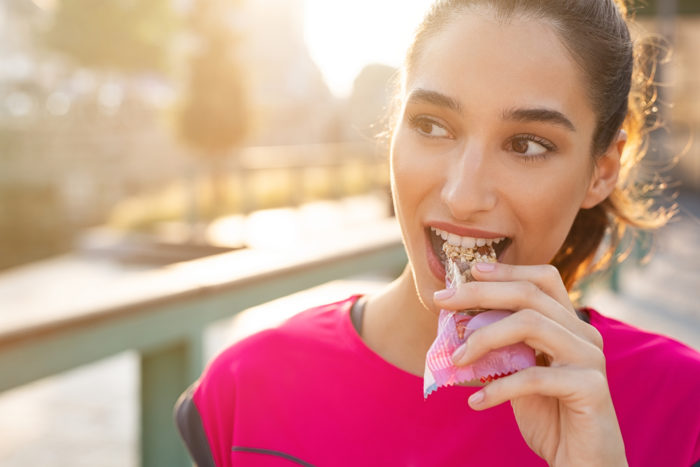
The Seeds Involved In Seed cycling
Each seed in the seed cycling protocol has been chosen for its unique benefits to your hormones. These seeds contain many properties that are essential to healthy hormone production.
During the follicular phase, flax and pumpkin seeds support estrogen balance. And during the luteal phase, sesame and sunflower seeds support progesterone production.
The omega-3 fatty acids, minerals, lignans, and vitamins contained in these seeds are essential building blocks for our sex hormones.
The seeds you use for seed cycling should be raw and freshly ground rather than pre-ground. Grinding your seeds on demand keeps the important nutrients and fragile fats intact and available for your body to use.
In a typical seed cycling practice, it’s recommended that you consume 1-2 tablespoons of each seed daily depending on the phase of your cycle.
Here’s a quick overview of each of the seeds used in a seed cycling protocol and how they can benefit your hormones.
FlaxSeeds (Follicular Phase)
Flaxseeds are a superfood when it comes to supporting estrogen balance. This hormone is the star in your follicular phase. This is why flaxseeds are included as part of the follicular phase cycle.
The lignans found in flaxseed can also be classified as a phytoestrogen. Phytoestrogens are plant nutrients that are structurally similar to estrogen. Because phytoestrogens can mimic estrogen, they may be able to reduce symptoms associated with low estrogen levels.
The lignans found in flax may also inhibit aromatase, an enzyme which catalyzes the conversion of androgens to estrogens. In addition, flaxseed lignans modulate the activity of enzymes involved in the balance between estradiol and estrone. This causes a shift in estrogen metabolism to favor the less biologically active estrogens.
So if you’re tending towards estrogen dominance or high estrogen production, consuming flaxseeds during the follicular phase may help bring those high levels down to normal.
This is how flax is able to balance our estrogen levels – by gently increasing our estrogen receptor activity while reducing elevated levels of naturally produced estrogen.
The fiber in flaxseeds can also help our bodies eliminate excess hormones that are secreted into the intestine for elimination via the stool. This is another way that flaxseeds can potentially improve our hormone balance.
And one study found that women consuming flaxseeds regularly were able to increase the length of their luteal phase by just over one day. This demonstrates the potential benefit to our hormones from consuming flaxseeds regularly.
Pumpkin Seeds (Follicular Phase)
Pumpkin seeds contain significant amounts of iron, magnesium, zinc, and healthy fats. All of these factors make this seed a good choice when it comes to supporting hormone balance. The zinc in pumpkin seeds is especially beneficial for the production of progesterone which is released in the second half of your cycle.
Pumpkin seeds also contain phytoestrogens. Like flax seeds, pumpkin seeds can help support the healthy production and clearance of estrogen.
Postmenopausal women have reported positive benefits from taking pumpkin seed oil to reduce the severity of hot flashes, headaches, and joint pain.
This study doesn’t relate directly to how pumpkin seeds would be used for seed cycling. But it does show that these seeds can play a role in balancing our hormonal ecosystem.
Sesame Seeds (Luteal Phase)
Sesame Seeds contain high concentrations of Vitamin E, which acts as a powerful antioxidant.
These antioxidants can help calm some of the inflammation that is associated with common pre-period symptoms at the end of your luteal phase.
Sesame seed consumption has also been shown to significantly increase levels of sex-hormone binding globulin (SHBG). SHBG is often low in women with PCOS, which can lead to symptoms of hormonal excess. Consuming sesame seeds could potentially help reduce some symptoms of this condition.
Sesame seed lignans also help balance excess estrogen, though they’re not as potent as the flaxseeds used in the first phase. This is primarily due to the total amount of lignans in each seed type: flaxseeds have 85.5mg per ounce, whereas sesame seeds have 11.2mg per ounce.
Sunflower Seeds (Luteal Phase)
Sunflower seeds are also high in inflammation-fighting Vitamin E as well as healthy fats and selenium.
The selenium content in sunflower seeds can help to promote healthy progesterone balance in the luteal phase. This is because selenium contributes to maintaining the function of the “corpus luteum”, the structure that forms after ovulation and produces the important spike in progesterone that happens in our luteal phase.
Selenium is also critical for optimal thyroid function. And if your thyroid isn’t functioning optimally, your sex hormones and menstrual cycle can be affected as well.

How to Use Seed Cycling to Balance Your Hormones
There are a few different seed cycling methods you can use depending on your current hormonal health, lifestyle, and goals. Each method will provide similar benefits to your hormones. I recommend choosing whatever way works best for you and your lifestyle.
Remember, introducing any new health practice into your life should be a source of freedom and a path to better health. It shouldn’t be something that causes anxiety or creates fear around doing it “wrong.”
Like anything else, practicing seed cycling doesn’t need to be done perfectly to provide benefit.
If seed cycling looks different for you than it does for someone else, it’s fine! Have peace knowing that you’re doing your best to support your body right where you are.
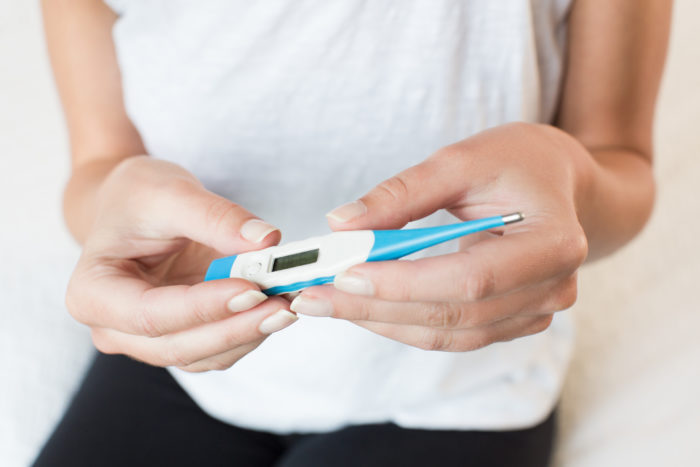
Seed Cycling Based on Your Cycle
The typical way to practice seed cycling is to cycle seeds based off of when you actually ovulate.
While this method is the most accurate, it’s also the most time-consuming.
The best way to know where you are in your menstrual cycle, and when you should cycle seeds, is by using a cycle tracking method.
To accurately track your menstrual cycle I recommend using the Fertility Awareness Method outlined in the books Taking Charge of Your Fertility and The Fifth Vital Sign, or using a tracking tool like the Daysy Thermometer.
Personally, I use Daysy to monitor my cycle. I love it because it takes the guesswork of tracking my cycle. Daysy employs a smart algorithm that accurately tracks my cycle after a few months. It then helps me confirm that I’ve ovulated and have moved from the follicular to the luteal phase. I also pay attention to cervical fluid to be optimally aware of my ovulatory function.
Any tracking method you choose will help you determine when you’ve actually moved from the follicular phase into the luteal phase and when to cycle your seed consumption.
Here’s a graphic that can help illustrate how to use seed cycling when you’re tracking your menstrual cycle.
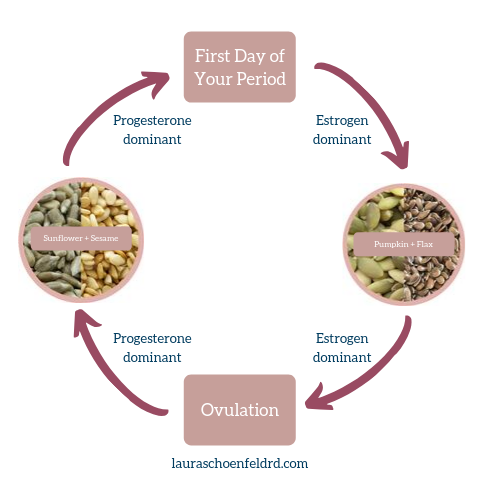
Would you like to save this post?
Your email address is 100% safe and will never be sent spam.
Using a cycle tracking method will enable you to determine when you have ovulated and should start consuming the seeds to support progesterone. And then when you get your period, you’ll know to switch over to using the seeds that support the estrogen dominant phase of your cycle.

Seed Cycling Based on the “Standard” Cycle
If tracking your cycle using the Fertility Awareness Method or a Daysy Thermometer just doesn’t sound like a good fit for you, don’t worry, you can still use seed cycling!
Cycling seeds based off of the “standard” 28-day menstrual cycle is the most straightforward way to seed cycle.
I do put “standard” in quotations because it’s very likely that your cycle is not exactly 28 days and you don’t ovulate precisely on day 14. (I know I don’t!)
This is simply the conventional medicine model of a typical menstrual cycle. Cycling your seeds based off of this conventional model will give you similar benefits as if you were tracking your exact cycle, without having to actually track your cycle.
If you choose to use this method, you would use days 1-14 (starting on the first day of your period) as your follicular phase, and days 15-28 as your luteal phase.
Since you aren’t directly tracking your own cycle, these standard 14-day phases won’t line up perfectly with what’s actually happening in your body. But over or undershooting cycling seeds by a few days won’t negatively affect any benefits of this practice.
This method is going to be best if your cycles fall somewhere between 24 and 32 days in length. If your cycles are outside of those parameters, using the next method might be best for you.
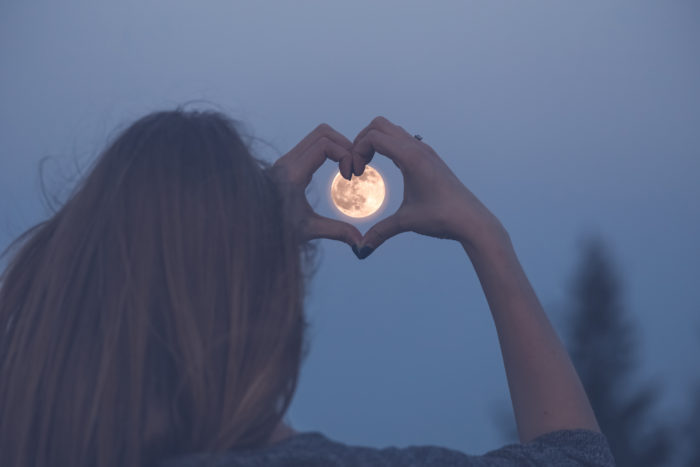
Seed Cycling Based on the Moon Cycle
If you currently aren’t getting a period or if your cycles are extremely long and/or irregular you might want to consider cycling seeds based off the moon cycle.
Conveniently, the moon cycles (from new moon to full moon to new moon again) occur on a 28-day cycle.
This provides a perfect template for any woman looking to support her hormonal health using seed cycling, but who doesn’t have a regular cycle to track.
If you choose to use this method, you would start seed cycling on a new moon. You would treat this new moon phase as the follicular phase.
Then after day 14 of the moon cycle, when a full moon occurs, you would switch over to consuming the luteal phase seeds. The “luteal phase” would last until after day 28, with another new moon.
The theory behind cycling seeds with the phases of the moon is that it can help your body get back into the rhythm of a 28-day cycle.
Here’s a graphic to help illustrate when you should cycle seeds based on the phases of the moon.

To be fair, there are no scientific studies to support this practice. Sadly, women’s health isn’t a huge priority in the research world these days, and seed cycling with the lunar calendar will most likely never be studied! But using seed cycling along with other methods to help balance hormones won’t hurt your chances of regaining a normal cycle. So it’s worth trying as part of your complete period recovery approach.
If your cycles are irregular or totally missing, I can help! I developed a free training dedicated to helping women regain normal menstrual cycles naturally (without The Pill!)

How Seed Cycling Can Be Effective for Hormone Balance
In theory, seed cycling seems like it could be a positive tool to help balance hormones. You’re consuming foods that have been shown to help balance your sex hormones when they’re most dominant in your cycle.
Keep in mind: like many other popular holistic health practices, there haven’t been any studies done that show that seed cycling is actually responsible for any hormonal changes or benefits.
This doesn’t mean that there are no benefits to seed cycling at all. It just means that these benefits haven’t been studied and proven effective.
Scientific research is expensive and time-consuming. These two factors make it easy for pharmaceutical companies or hospitals to get funding to research a new drug or treatment protocol.
But this also makes it fairly prohibitive for studies on food or other alternative medical treatments to occur. There just aren’t many people who will provide funding to study whether or not seed cycling can help support women’s menstrual cycles.
It’s well known that there is a massive gender bias in clinical research and it’s only been about 20-30 years since women were even required to be included in clinical trials. Studying the menstrual cycle and the factors that influence it just isn’t a high priority on the list of medical research topics.
Because of this, we frequently have to rely on anecdotal evidence, along with our own best judgment, to determine if these holistic practices have any benefit.
There is evidence that some of the seeds included in a seed cycling practice do have proven benefits for hormone balance. And including these seeds in your diet, seed cycling or not, can help support healthy hormones.
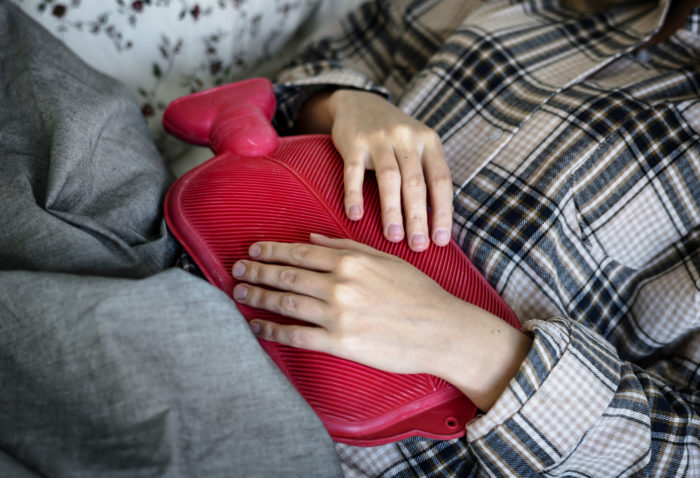
Seed Cycling to Reduce Period Symptoms
Experiencing hormonal symptoms at certain times in your cycle is frustrating and downright uncomfortable.
If you’ve been dealing with PMS or other unpleasant symptoms at any point during your menstrual cycle, seed cycling might help.
There aren’t any studies on the practice of cycling seeds in particular. But research does point to benefits of consuming some of the seeds in a seed cycling protocol to support the reduction of period symptoms.
One study showed that flaxseed consumption can help to reduce breast tenderness during PMS. This may be due to the impact flaxseed lignans have on estrogen metabolism.
Cramping around the start of your period is typically a result of an increase in inflammation. Seeds are high in inflammation-fighting omega-3 fatty acids and antioxidants that can help to relieve this painful cramping.
Remember: Our hormones can take some time to respond to any changes we make, whether from consuming seeds or not. Three months is usually a good time frame to evaluate whether or not any changes you’ve made are helping banish your period symptoms.
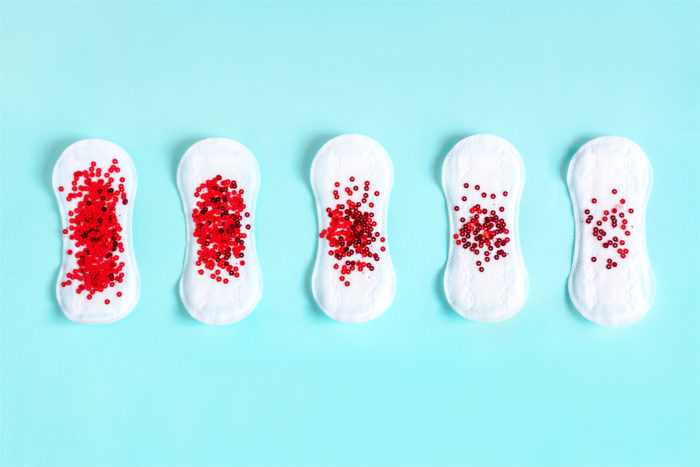
Seed Cycling to Help Regulate Your Cycle
Cycles that are longer or shorter than average, or that vary widely from month to month, can all fall under the umbrella of menstrual cycle irregularity.
There is currently no definitive evidence that seed cycling specifically can help regulate your cycle. But in my experience, eating these seeds certainly won’t hurt! And many women I’ve spoken with in my Get Your Period Back program found a benefit to experimenting with seed cycling.
In general, consuming seeds (or other healthy foods) is going to help you produce healthy, happy hormones. Seeds contain plenty of healthy fats, nutrients, and fiber that are all precursors to balanced hormones.
Cycling seeds, while it can be beneficial, likely isn’t necessary for you to see hormonal benefits. Just consuming these seeds on a regular basis can provide a similar benefit as cycling them would.
And consuming seeds is just one piece to regaining hormonal balance. Your overall diet, lifestyle, and mindset are also critical pieces that shouldn’t be ignored when it comes to supporting healthy cycles.
If you’re not getting a period, check out my free training dedicated to helping women regain normal menstrual cycles naturally.

Seed Cycling to Help Promote Return of Fertility
When it comes to using seed cycling to promote ovulation and return of fertility, the evidence is only anecdotal at this point. There are no scientific studies showing that consuming seeds at different points in your cycle can help your body start to ovulate again or to ovulate more regularly.
That being said, this doesn’t mean that you should completely discount seed cycling. I’ve seen many clients and women in my Get Your Period Back program have success recovering from amenorrhea by using seed cycling as a tool to help them get there. (In the context of a complete lifestyle program, of course!)
Cycling seeds based on the phases of the moon is a good option for women who are dealing with amenorrhea or very long, anovulatory cycles.
You can also just focus on consuming flax seeds, along with other measures, to help regain a normal cycle. One study showed that when women ingested flaxseed for a few months, they ovulated more often than when they didn’t eat flaxseed.
Do I think you can completely recover your cycles using just seed cycling alone? NO.
But using seed cycling (or just consuming flax seeds) in conjunction with evidence-based diet, lifestyle, and mindset shifts can give you a leg up when it comes to recovering from amenorrhea.
If you’ve tried to regain your cycles on your own and just haven’t had any success, I can help! I developed a free training dedicated to helping women regain normal menstrual cycles, naturally.

My Recommendations for Seed Cycling and Hormone Balance
Can seed cycling really help balance your hormones?
In short, yes. Making these seeds a part of your healthy diet and lifestyle can potentially help balance your hormones.
But you don’t need to follow the strict seed cycling protocol to see benefits. Just eating these seeds alone, on a cyclic basis or not, will give your body a boost of healthy fats, vitamins, and nutrients that promote healthy hormone production.
These building blocks can then help to regulate your menstrual cycle or relieve some painful period symptoms.
And the fact is, there’s no science-based evidence that seed cycling specifically has any additional benefit over just simply consuming these seeds.
If it’s causing you stress or anxiety to try to remember to cycle the seeds and consume them each day, don’t worry about it. It will likely be just as beneficial for your hormones to include these seeds in your day when you can.
Not tying yourself down to a strict seed cycling protocol, and just letting these seeds be another part of your healthy diet, can go a long way in preserving your mental wellbeing in your journey to healthy hormones.
Seed cycling does give you a template for rotating these seeds on a consistent basis. This provides your body with a variety of these essential nutrients to support healthy hormones.
And some awesome new products like Food Period can help make seed cycling a no-brainer.
So if you can fit seed cycling into your routine, go for it! But, if the rigid protocol is causing you stress, leave it out.
Simply consuming these seeds as part of your regular diet enables you to still get the benefits of hormonal health while freeing you from strict food rules and protocols.

Other Ways to Help Balance Your Hormones
Seed cycling isn’t the only method you can use to support healthy, happy hormones.
Other ways you can positively support your hormones are:
- getting enough sleep
- eating enough food
- moving your body in nourishing ways
- cultivating positive relationships
- managing your stress
Practices to improve your health shouldn’t be burdensome, and you shouldn’t be doing them because you think you need to.
You can be just as healthy and have balanced hormones whether you seed cycle or not.
The most important thing is that you choose to focus your time and energy on health-promoting practices that bring you joy. These practices should enable you to use your health as a tool to pursue a greater purpose in the world. They shouldn’t cause you more stress and anxiety about doing them perfectly.
With or without seed cycling, focusing on practices that both improve your health and fit into your current lifestyle will ultimately give you the best results.
Have you tried seed cycling? Are there any benefits you’ve noticed from consuming these hormone balancing seeds? Let me know in the comments below!
This post may contain affiliate links. If you click on a link and make a purchase, I may receive a small commission.

+ show Comments
- Hide Comments
add a comment